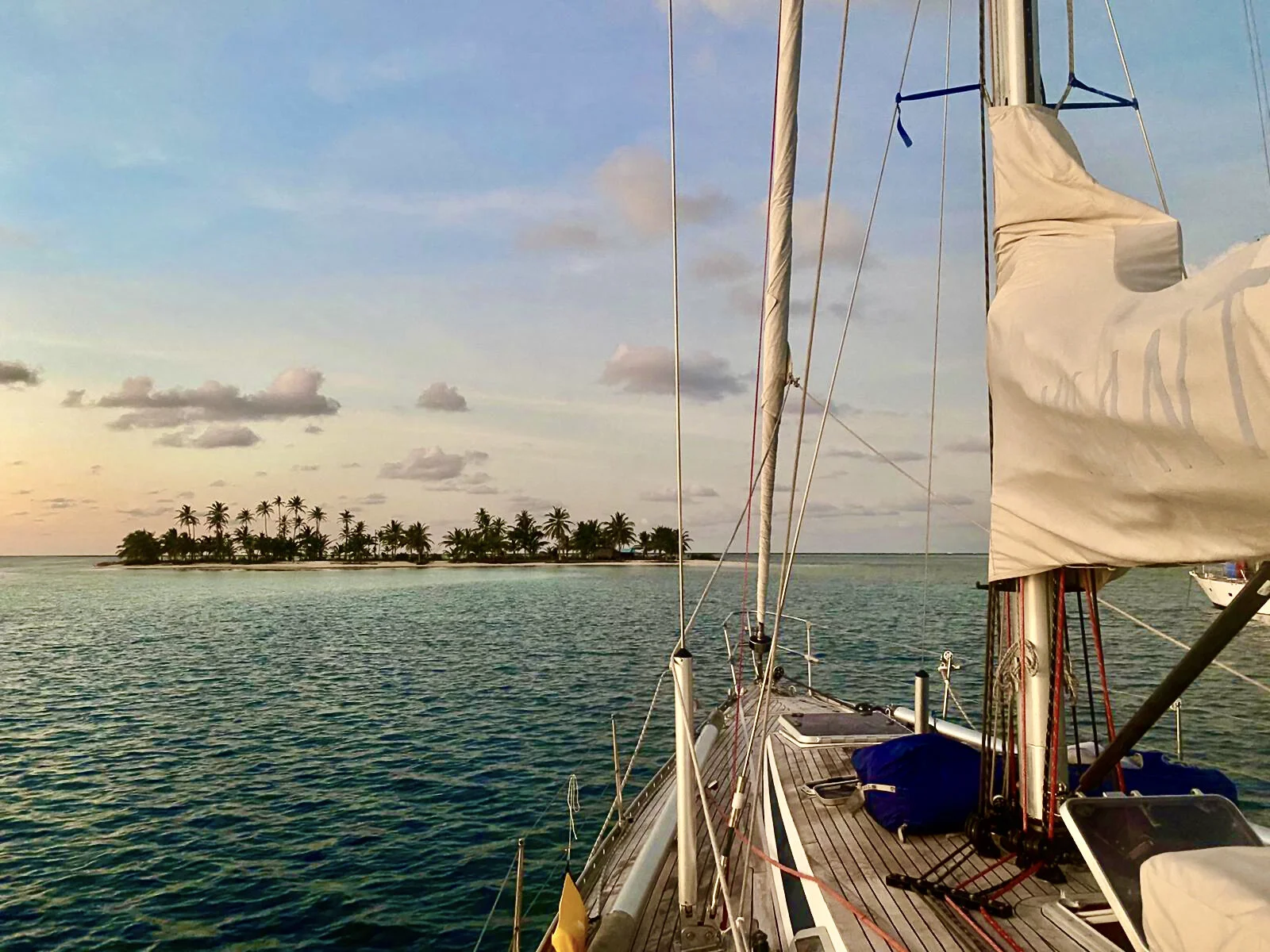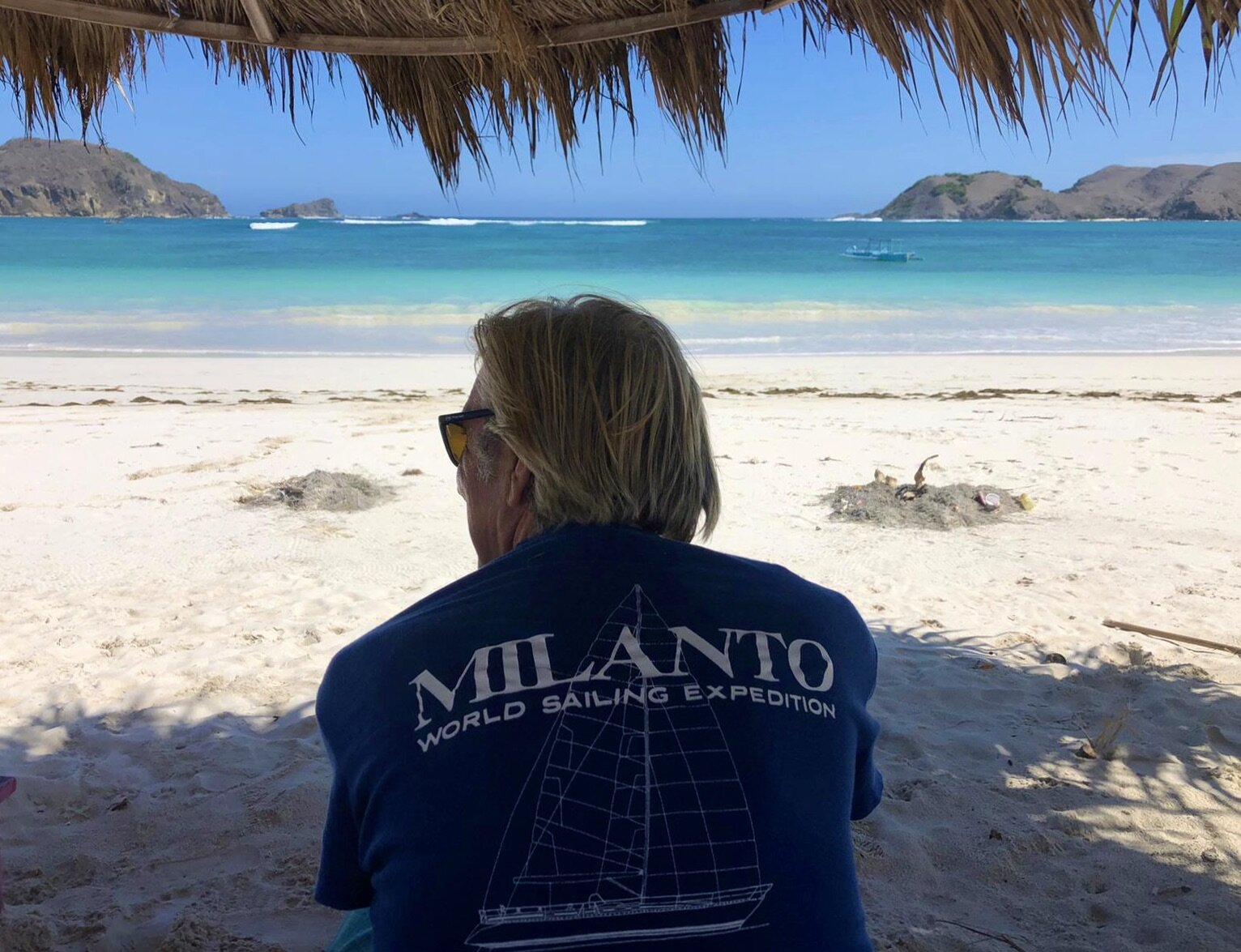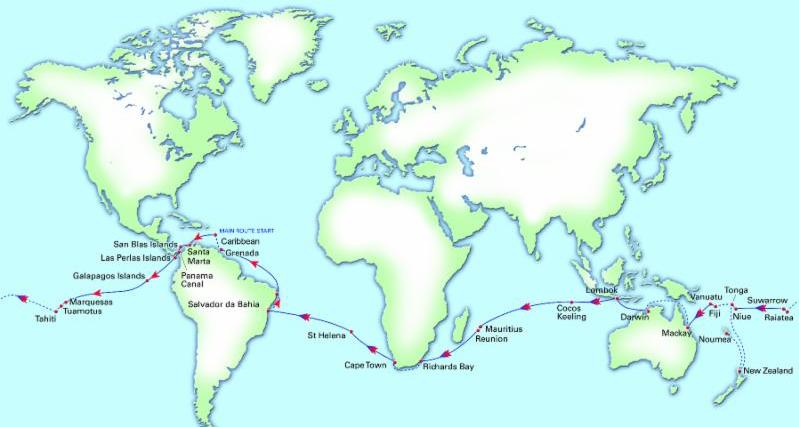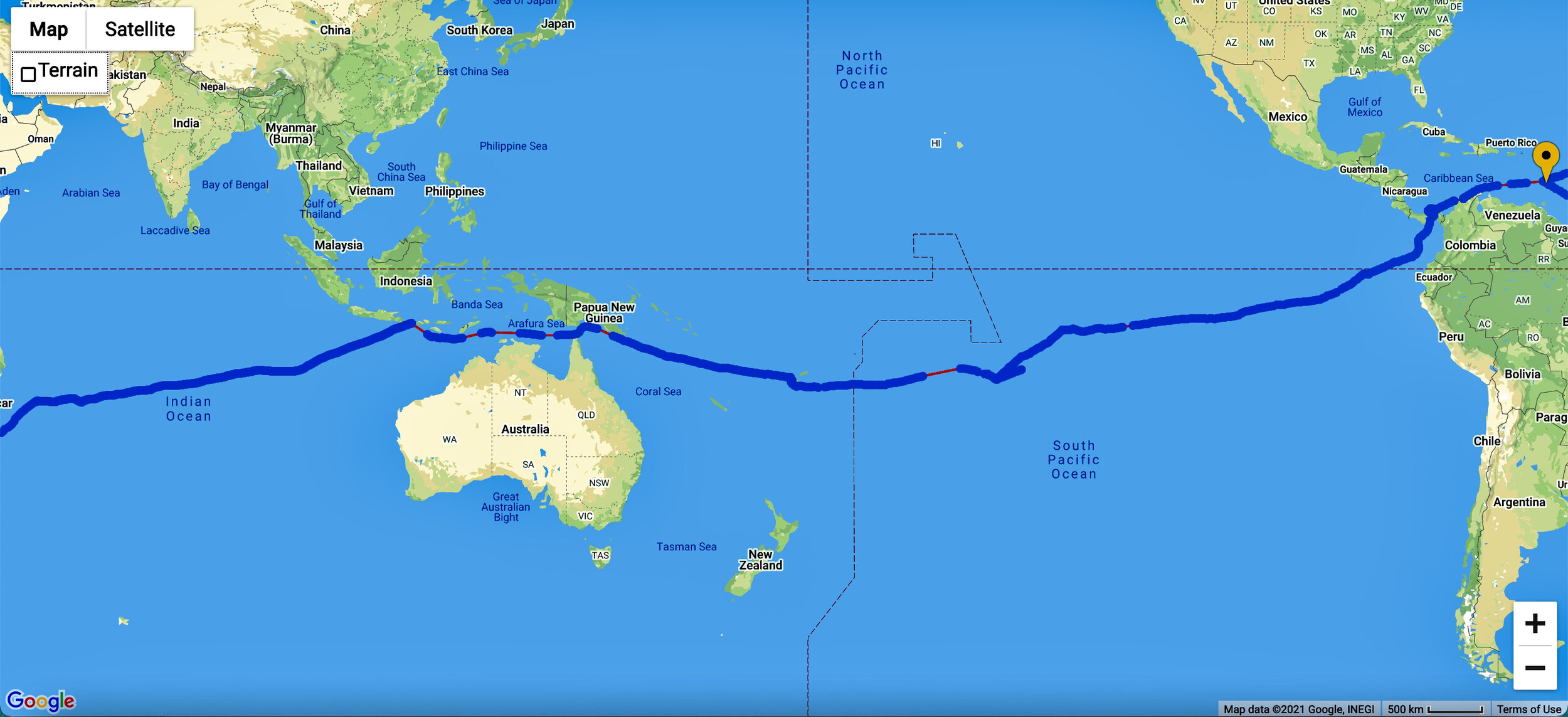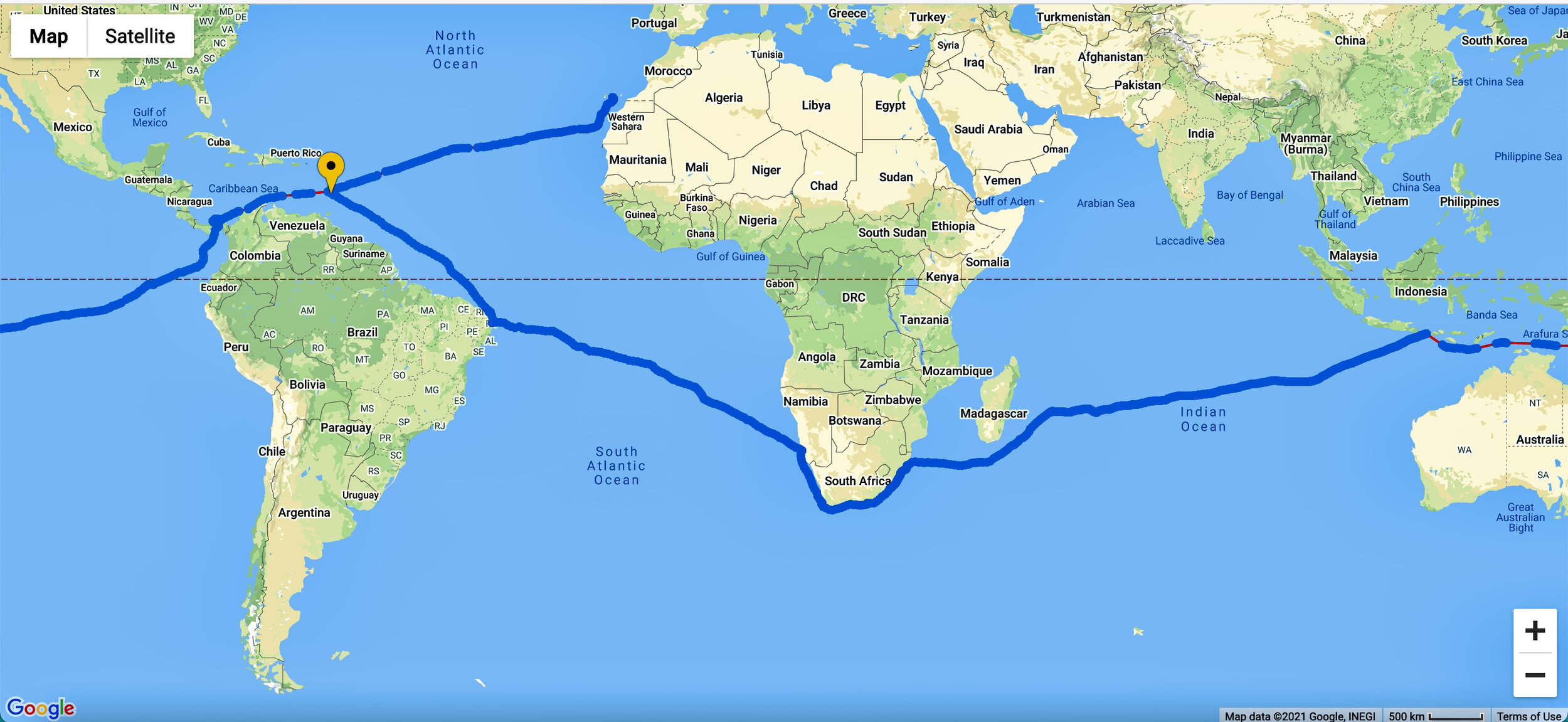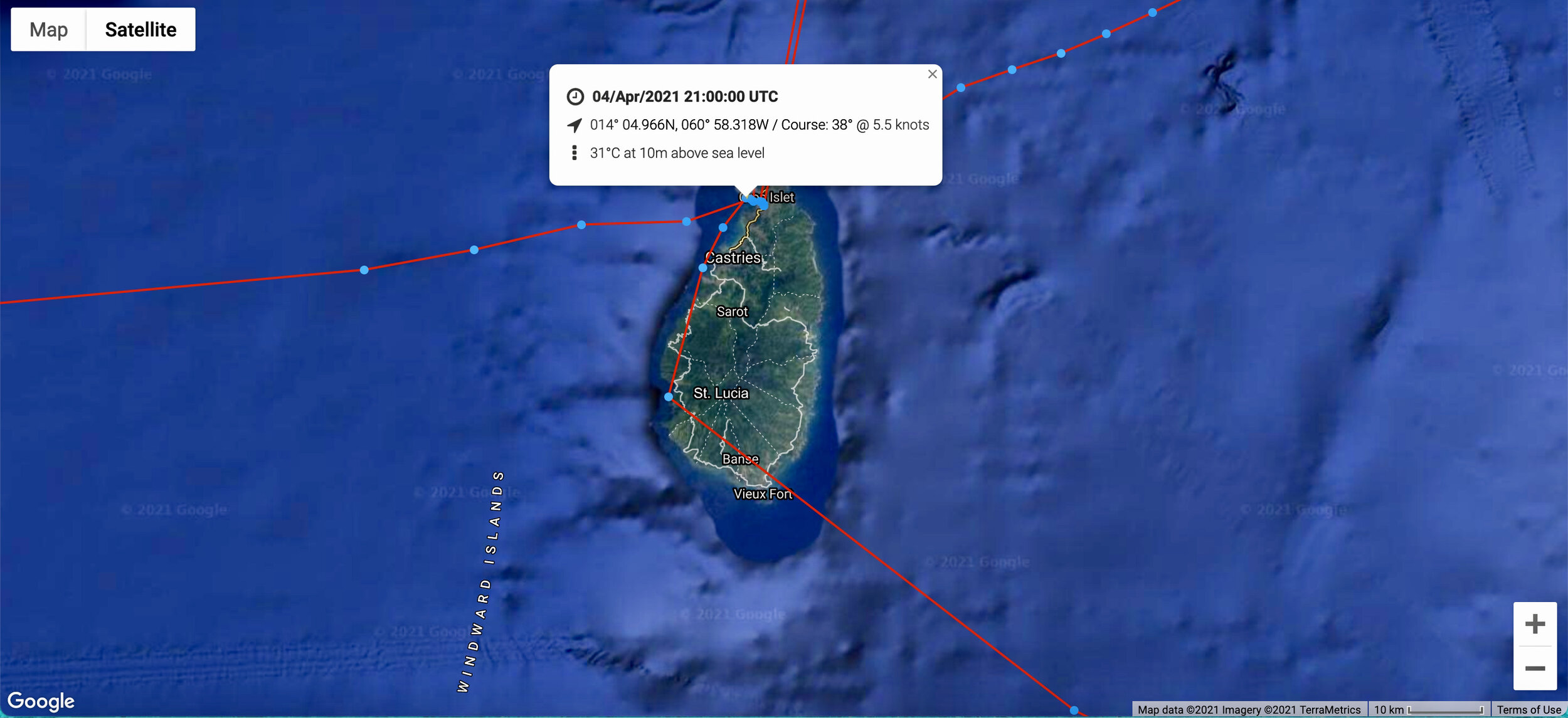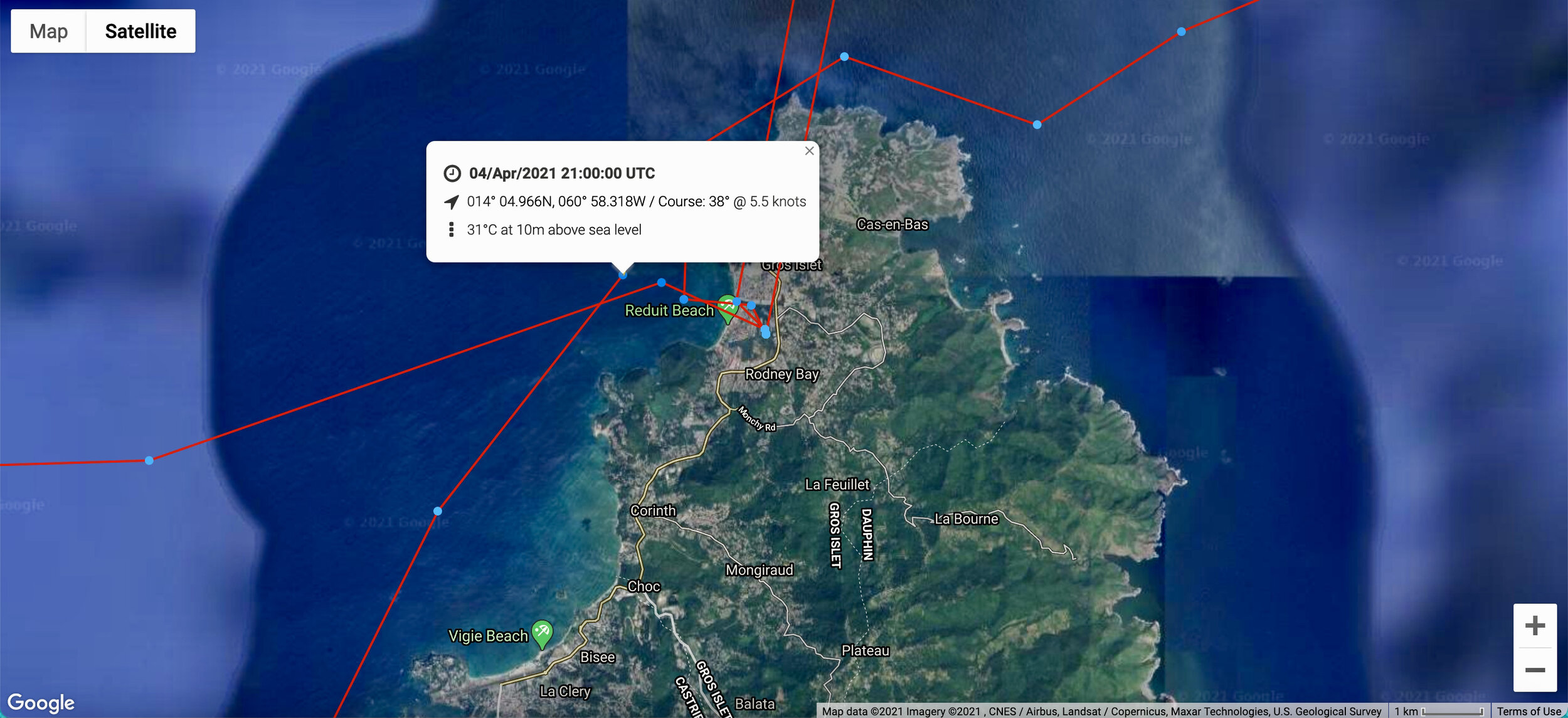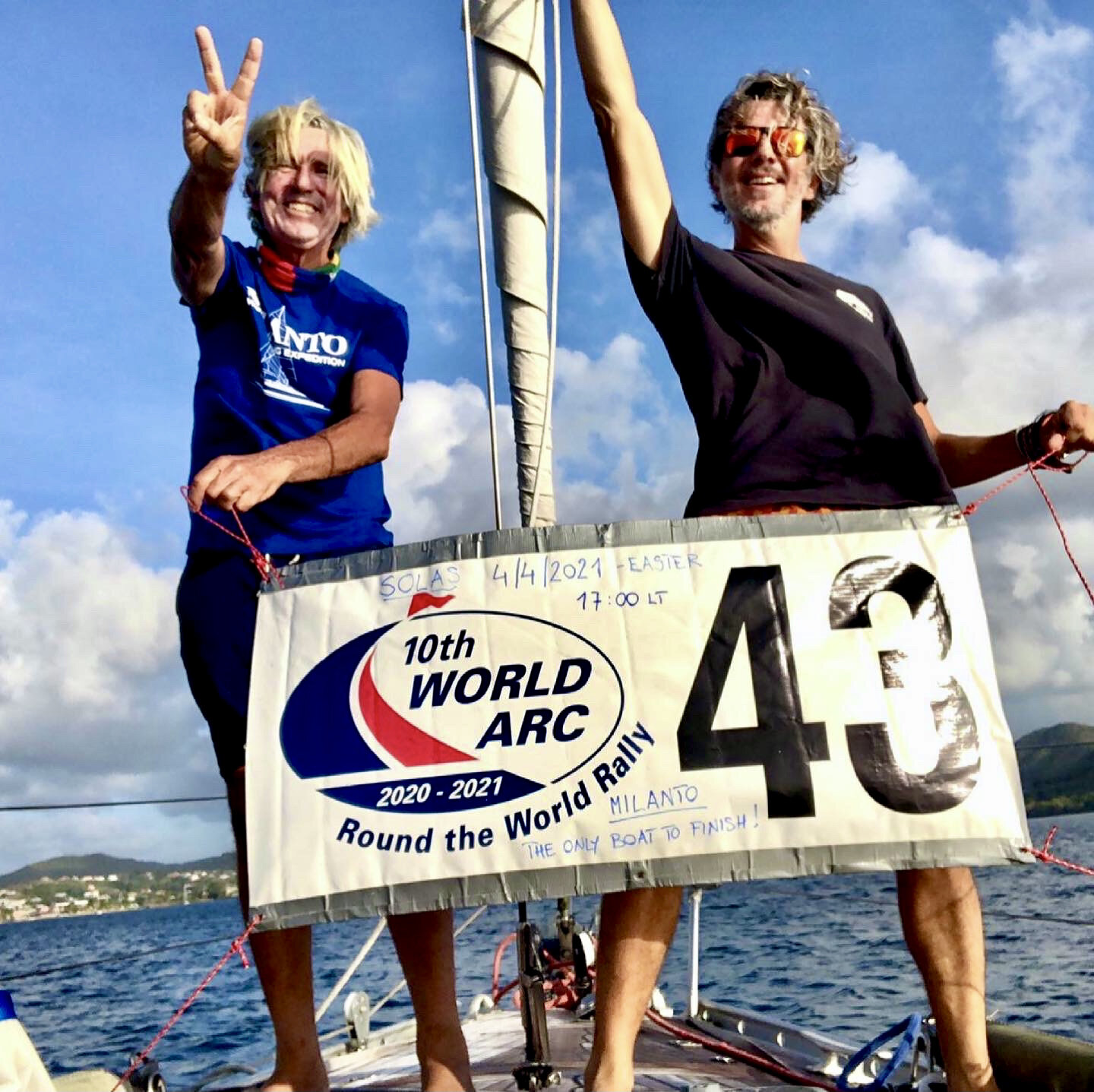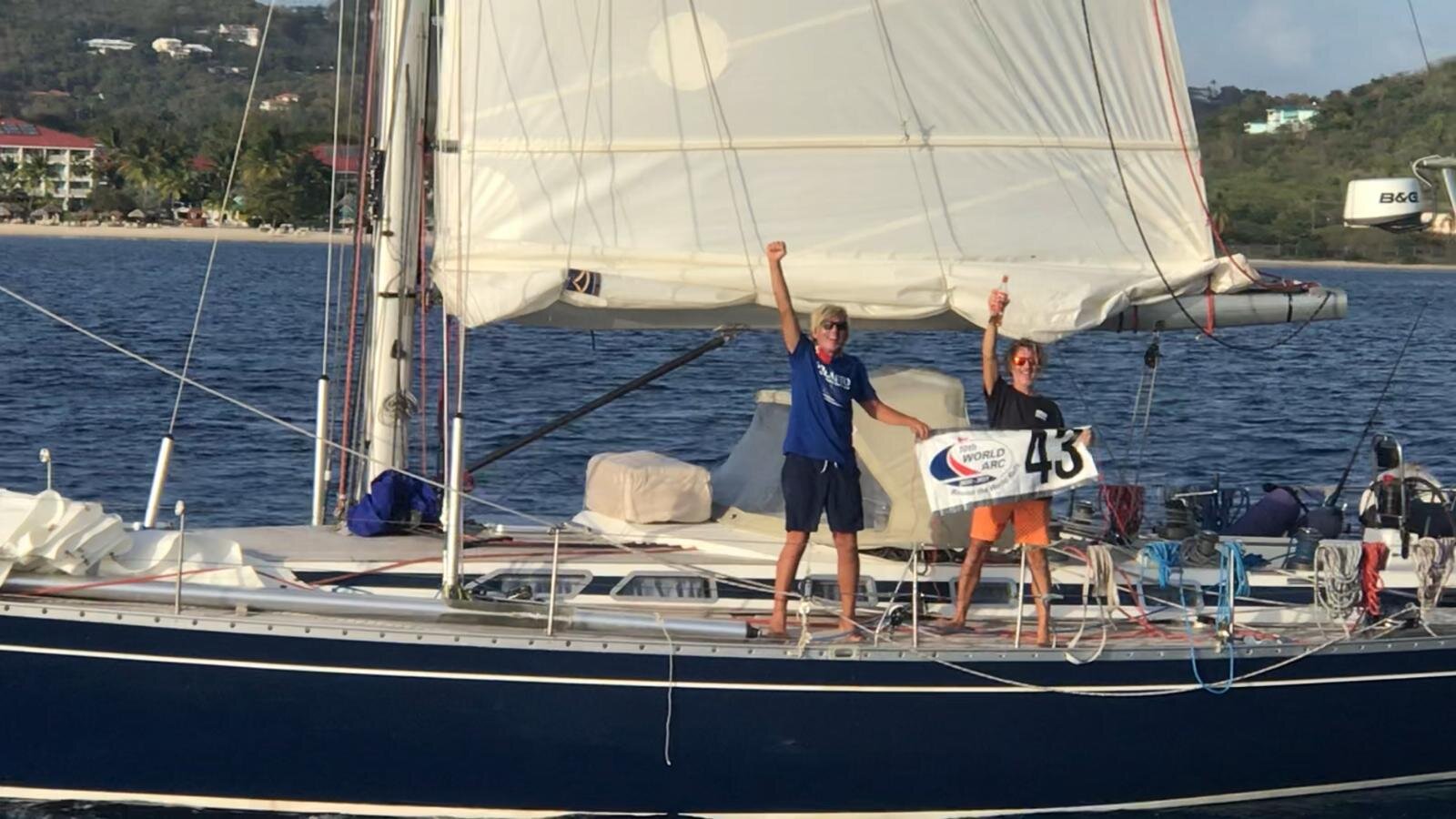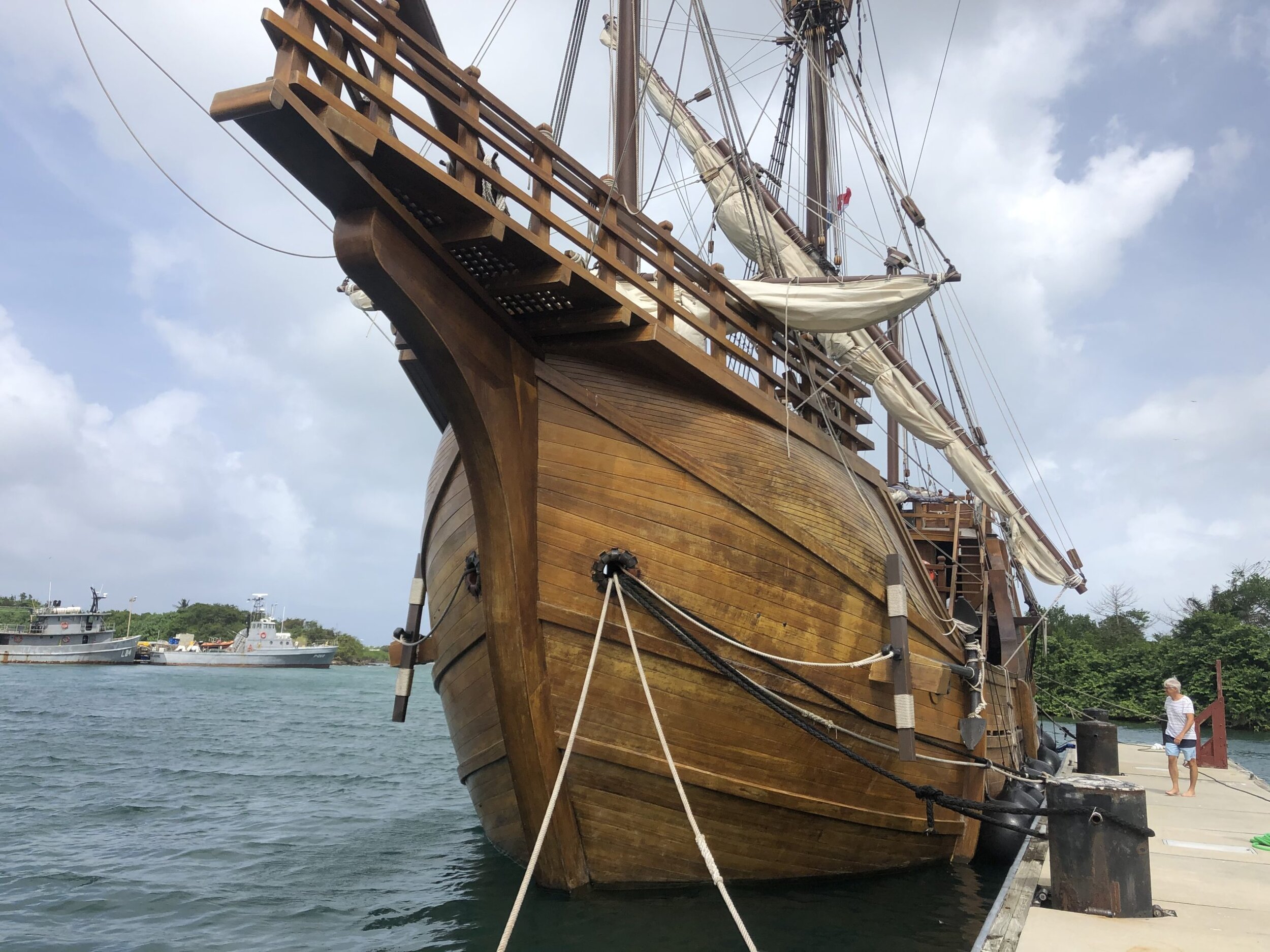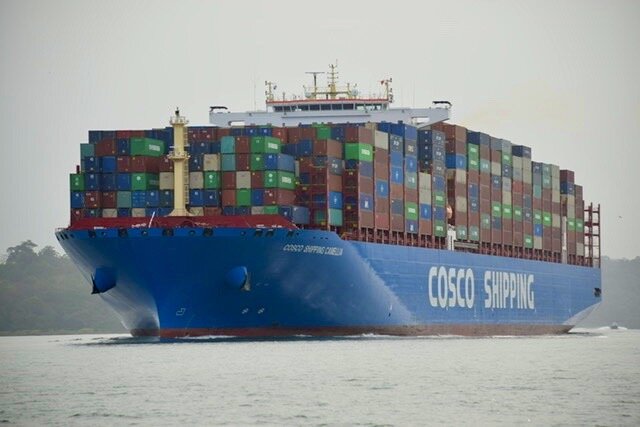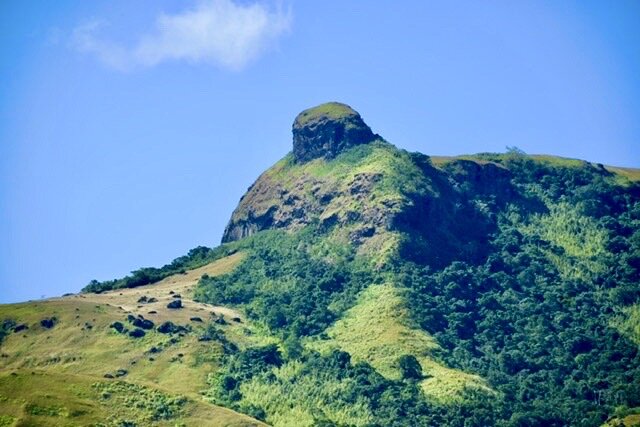World Sailing Expedition 2020-2021
the plan
This round-the-world journey took 15 months and covered approximately 25,000 nautical miles.
Just those simple facts make this the real adventure of a lifetime.
A small fleet of around 40 boats left the dock in Rodney Bay Marina, St. Lucia on January 11th, 2020. With a course set for our first stop, Santa Marta, Colombia.
At that point, we had only briefly met the other crews at the pre-departure parties, but we soon came to realise (especially significant with how the year turned out), that we would quickly form an intimate community of friends that would provide immeasurable reassurance and support throughout our time together.
The start in St. Lucia. January 11th, 2020The Route
The tried and tested route for what was the 10th anniversary of the World ARC (WARC), followed the trade winds, ensuring that we would cross the Pacific and Indian oceans during the fastest period, at the height of the trade wind season.
The route left from the Caribbean, through the Panama Canal, then across to explore the Galapagos Islands. We then sailed one of the longest ocean passages possible, before being rewarded with the incredible beauty of the numerous Pacific Islands. Unfortunately, it was in Tahiti that the World ARC was suspended due to the Covid-19 pandemic.
We were then supposed to sail to Australia, leisurely exploring the east coast and the Great Barrier Reef, but by then its borders were closed to us. So we headed straight for the Indonesian island of Lombok, before crossing the Indian Ocean with a brief stop in Réunion Island. We then pressed on to Richard’s Bay in South Africa, before slowly and safely working our way down the coast, finally arriving in Cape Town for Christmas.
In the new year we made our way to Namibia, before once again crossing the Atlantic, with an overnight stop at Napoleon’s prison of Saint Helena. Carnival in Rio was cancelled, but after a short, restful stop in Cabedelo, Brazil we finally returned to the Caribbean region completing our circumnavigation in Saint Lucia.
The original World ARC route and stopsEach yacht was fitted with a satellite tracker that provided automatic position updates so that family and friends could follow our progress.
We did the circumnavigation as a charter yacht, selling berths to individuals so that anyone could have the opportunity to join us on this adventure. The intended ‘charter’ itinerary was divided into legs each lasting around a month. Some were ocean passages with high mileage and some were pure cruising and exploring oriented, and then some were a combination of both - long passages mixed with shorter exploratory cruising.
Our final route, similar but with fewer stopsThe finish, on 4th April, 2021 - Easter day!You can use these links to see our posts during the circumnavigation:
https://www.facebook.com/MilantoSailingExpedition/
https://www.instagram.com/milanto46/
https://www.instagram.com/lorenzo.roundtheworld/
Or read about our journey below from the blogs of
first mate, Lorenzo Cipriani.
Leg 1: Saint Lucia, Santa Marta, San Blas Islands, Panama Canal, Panama City
11 January 2020 - 10 February 2020
Leaving from Rodney Bay in Saint Lucia we headed southwest 815nm away to Santa Marta, Colombia.
We then headed for the San Blas Islands 2 days sail away. The islands are governed by the indigenous Guna Indians and are made up of over 300 islands (most of them uninhabited).
The fleet then converged in Colón in preparation for the transit of the canal. Each boat was assigned a transit day in which to begin the transit, then it took two days to move through the 80 miles and 3 locks of this impressive human-made waterway to reach the Pacific Ocean. We ended this leg in Panama City.
Blog
The Diamond Rock
The Diamond rock is an islet that emerges from the sea south of Martinique. It takes its name from the shape and reflections it takes at certain times of the day…
The emerald green of the Caribbean Sea…
Imagine living in a washing machine for 4 days and 4 nights: preparing the main meals, managing the navigation, adjusting the sails, making electronic correspondence, setting the course according to wind and sea conditions…
Santa Marta, between the sea and the Sierra
“A la una y tres minutos de la tarde murió el sol de Colombia”. So said the official statement of December 17, 1830 when Simon Bolivar, the Liberador, who was the architect of the process of independence of part of Latin America from the Spanish yoke, founder of Colombia and Bolivia…
Cartagena, the restless city
Few people know that Francesco Carletti, a Florentine, was the first private merchant to circumnavigate the globe without official assignments, but by his own means following a route…
The Guna of the San Blas islands
We set sail from Santa Marta, Colombia at 12 noon on Wednesday, 23 January with a route heading for the San Blas islands, in front of Panama. Passing the Cape of Barranquilla was not easy…
Back to the Origins
Carlos is the commander of the replica of the Santa Maria, the flagship of the famous fleet of caravels in the first journey of Christopher Columbus…
Rise to the Pacific
The Panama Canal is not only the border crossing between two oceans, but also between two different worlds, between two different cultures…
Leg 2: Panama City, Las Perlas Islands, Galapagos
12 February 2020 - 23 February 2020
From Panama City we cruised to the Las Perlas Islands, 45nm away. More than 250 tiny islands make up this archipelago, getting its name since Spanish colonial days because of the many pearls that were found there. We had a few days to explore the area before meeting up with the other WARC boats and setting sail for the Galapagos.
We departed for the Galapagos on the 12th February, with a passage of approximately 850nm and our first stop being San Cristobal island.
The unique and diverse ecosystems of the Galapagos Islands - extending from the land to the sea - meant that it has earned the title of being a living museum, where you can still observe species that are not found anywhere else on the planet.
On land, there was the opportunity to get up close to sea lions, giant tortoises, seals, iguanas and an immense amount of different bird life. Under the sea, it was no different with multitudes of different fish, sharks, dolphins, whales and penguins.
We ended this leg in Santa Cruz island only a day’s sail away from San Cristobal, where we took advantage of more opportunities to dive, snorkel, kayak and hike.
blog
Panama Hat
Panama is a metropolitan area that extends over a very large territory where almost two million people live today. In the few days that I have spent here I have tried to understand its spirit…
The line-crossing ceremony at the equator and the arrival in the Galapagos
Around 30° latitude north and south of the equator you enter an area of variable winds where you happen to stumble across the calm equatorial conditions…
The mystery of the Baroness of Floreana
After almost a week spent visiting the natural wonders of the Galapagos Islands according to Darwin’s famous descriptions: the craters of the numerous volcanoes, the lava tunnels and the lush vegetation…
The doubts of an ecological conscience
During these first two months of travel we have often wondered about the ecological protection of the places we visited and, as often happens when you go into the complex issue such as the environment, things instead of becoming simpler, become more complicated…
Leg 3: Galapagos, Marquesas
4 March 2020 - 23 March 2020
This was the classic trade wind, 3000nm downwind Pacific Ocean leg. The passage took 19 days and during that time we settled into the different pace and routine of life at sea.
After weeks of seeing endless horizon, our first sighting of Hiva Oa in the Marquesas was no doubt similar to how Paul Gauguin saw it when he first arrived in the Marquesas in 1891 - a dramatic mix of lush jungle, sea-battered coastal cliffs and towering volcanic peaks.
It was in Hiva Oa that we first learned of the far-reaching impact of the pandemic and sadly were not allowed to leave our boat at anchor. We stayed there for ten days in quarantine on board, receiving provisions and fuel from the shore, before we were instructed to proceed to Tahiti.
BLOG
The Pacific in the time of the virus
When we sailed from the island of St. Lucia on January 11th, I believed in the extraordinary opportunity that life was offering me…
Leg 4: Marquesas, Tahiti
31 March 2020 - 8 April 2020
We were only allowed by the Tahitian Government to proceed directly to Pepeete. Sadly, it meant that we were unable to explore the Marquesas or the Tuamotus atolls as was originally planned en route to Tahiti.
Arriving in the vibrant capital city of Papeete, we finally met up with the WARC fleet again and together readjusted to our new reality. Soon after the WARC was suspended and the fleet disbanded as everyone tried to find their own best path forward.
blog
Milanto’s unreal journey to the Society Islands
I am writing this from Taina Marina, in Papeete, Tahiti. We are moored on the dock and touching our feet on the land for the first time after more than a month spent at sea…
‘Shall I compare thee to a summer’s day?’ Calypso on the island of Tahiti
I wake up early in the morning, prepare tea, go out on the deck of Milanto and sit at the bow. The island of Moorea is always in front of me…
Tahiti Iti and the garden of Eden
Tiaou waves his arms and raises the volume of the music to let us know that we are welcome to anchor in front of his home. He lives in a small house on the shore of the lagoon…
Three Polynesian legends
A book of Polynesian legends, purchased by a friend in a Tahitian bookshop, sparked my curiosity. I understood that in these myths lies the core of the culture of these places…
Leg 5: Tahiti, Tuamotus, Society Islands, Bora Bora
9 May 2020 - 27 June 2020
After a month’s lockdown in Tahiti with restricted movement in public places and unable to leave port, we finally got approval from the Tahitian Government (with the right papers and protocol obeyed), to explore the Society Islands and the Tuamotus. We decided that returning to explore the Tuamotus - that we had sailed past when coming into Tahiti - was worth the effort of making a return journey.
The visually striking Tuamotus are made up of 77 atolls - which are narrow coral rings encircling a pristine turquoise lagoon. The best part is that most of the places we visited were only accessible by boat. It lived up to the legends of the French Polynesian islands as being a heaven on earth, with its laid back, guilt-free lifestyle surrounded by a lush, pristine environment. However, we also had an encounter with mother nature which forced us to return to Tahiti for some minor repairs.
Afterwards, we cruised through the Society Islands of Mo’orea, Huahine-Iti, Ra’iatea and Taha’a, where each island had its own offering of something to explore and indulge in: Polynesian temples, vanilla and pearl farms, mountain hikes, shallow coral lagoons and waterfalls.
We then made our last stop in French Polynesia the island of Bora Bora, one of the most geographically stunning islands with its majestic volcanic peaks, encircling reef and crystal clear lagoon.
From there, bypassing the Cook Islands, Niue and Tonga (which was on the original WARC itinerary), we headed directly for Fiji as it was still accepting visiting yachts.
blog
The Honeymoon Island
Moorea is that island of Polynesia where couples from all over the world come on their honeymoon. Not far from Tahiti, it has volcanic topography like the other islands of the Society…
The dangerous archipelago
We got lucky, it could have been worse. This is often said when the danger has passed. When the tension drops, the damage is assessed and it is clear that no one has been injured, except for some scrapes…
The farthest record shop in the world
In the centre of Papeete, near the central market – in a large structure covered in red and white iron sidings, where pearls and fruit, flowers, fish and coconut milk are sold – there is a small temple of music…
The ancient spirits of Raiatea and today’s crimes
They came from every island in Polynesia to celebrate the union of the people who inhabited a large area of the Pacific called Te-Moana-Nui-o-Hiva, otherwise known as the Polynesian triangle…
Bora Bora is the greatest gift
‘David, don’t get into trouble!’ Federica shouts to her little son, who following her, has jumped out of the jeep and is running towards the rubbish bins. She is an Italian from Milan, who has lived in Bora Bora for years…
Leg 6: Bora Bora, Fiji
6 july 2020 - 25 July 2020
Fiji is made up of two main islands, Viti Levu and Vanua Levu. We were directed by port authorities to head direct to Port Denerau in Viti Levu. After clearing their entry requirements and quarantine period we were able to explore these islands, indulging in its rich history and culture and enjoying the world-class water sports of surfing and diving.
At this point, we were in conversation with the Italian Consulate in Australia who were lobbying for approval for Milanto to be able to stop in Australia. There were concerns about the approaching cyclone season in the Pacific and we were conscious of being caught in their pathway as the season was about to start.
After much communication with the government we were denied entry to Australia, not even an overnight offshore stay to rest, provision or refuel was allowed. It left us in a predicament with a difficult decision to make on whether to leave the boat in the boatyard in Fiji and return to Italy, or proceed with the very long and challenging route to Lombok. Obviously, we pushed onward.
Blog
The value of friendship and the ghosts of Fiji
We sailed on the morning of Monday, 6th July from Bora Bora, with a course set for the Fiji islands, in a flotilla of three boats: Milanto, Ariel and the catamaran, Sea Lover…
Hands-on Fiji
The period of British colonialism in Fiji is so long ago that few vestiges of those years remain…
Leg 7: Fiji, Lombok
14 august 2020 - 12 september 2020
We started from Port Denerau and spent a night in the idyllic Yasawa islands in outer Fiji before setting sail for our long journey (3000nm), across the Indian Ocean to Lombok, Indonesia.
The original itinerary had intended us to stop in Vanuatu, exploring the surrounding archipelago consisting of around 83 islands. We were then to depart Port Vila and set sail for Mackay, Australia on the southernmost point of the Great Barrier Reef. But with its closed borders, we had no choice but to head directly to Lombok, who were still welcoming visiting yachts.
Lombok was previously called the sister island to the nearby, world-famous island of Bali, but its pristine unspoiled nature has made it rise in popularity. In Lombok, we experienced the beautiful beaches with some top surf breaks and swam in the deep pools of the many waterfalls. It is also the home to the famous Mount Rinjani, where we hiked in the surrounds of the active volcano. But the most important imprint of the place was its people. It was a place where we wished we could stay longer and were genuinely sad to leave.
blog
Between sea and sky, Milanto’s long journey from Fiji to Lombok
When we left at the beginning of January, from the island of Saint Lucia in the Caribbean, our world tour was to be a dream made real, together with many people who would share with us…
Lombok’s gaze
‘The courage of a sailor does not lie in taking the waves, but in facing the departures,’ says Valerio as we tell each other about the experiences we have lived in these past two weeks in Lombok…
Leg 8: Lombok, Réunion Island
25 September 2020 - 17 October 2020
We left Lombok and sailed west across the Indian Ocean to Réunion Island. We had intended to have a brief stop at Christmas Island and the Cocos Keeling islands - an unspoiled exotic paradise, made up of 27 islands that are all palm-fringed with white sand beaches where a small indigenous population of about 450 Cocos Malay people live. We we then supposed to head for Mauritius, but all of these borders were closed at the time.
Réunion Island not only welcomed us but offered such majestic landscapes, with the formidable Piton de la Fournaise, as one of the world's most accessible active volcanoes. There were dramatic mountains with incredible panoramas, waterfalls and hiking trails that led us through deep gorges and emerald forests down to the white and black sand beaches.
blog
Per aspera ad astra, the crossing of the Indian Ocean
There is a passage in Jack London’s, The Call of the Wild that has always struck me: ‘There is an ecstasy that marks the summit of life, and beyond which life cannot rise. And such is the paradox of living…
The island of fairies
‘Come, let’s go find the tomb of the pirate La Buse!’ Danielle tells me as soon as I get in the car. We met at a party and she wants to show me around to get to know the island better…
Leg 9: Réunion Island, Richard’s Bay & Cape Town (South Africa)
5 november 2020 - 16 december 2020
From Réunion we headed for Richard’s Bay in South Africa, on the north coast of KwaZulu Natal. It was one of the trickiest passages when it came to wind, weather and currents all converging as you approach the South African coast. With an onshore router to help advise on weather windows, we safely made it to the ‘Rainbow Nation’.
Just outside of Richard’s Bay we made a trip to the Hluhluwe iMfolozi Park where we had our first encounter with big game such as Rhino, Kudu, Hippo, Giraffe, Lion, Buffalo, Elephant and Antelope. Our next stop was in Durban just south of Richard’s Bay, a busy port city that had a major makeover leading up to the 2010 World Cup. Then working with the shifting weather patterns it was a quick stop in Port Elizabeth, before stopping in the idyllic local vacation spot of Knysna.
Moving during the next weather window we finally made it to Cape Town, with the unique topography of Table Mountain in the background making it immediately recognisable from a distance at sea. Cape Town had so much to explore just within the city limits, the Victoria & Alfred Waterfront (where we were berthed), was full of quaint restaurants, shops and art galleries.
We knew some local friends which made all the difference in helping us to settle into the rhythm of daily life and soften the blow of celebrating Christmas and New Year away from our families. Getting to Cape Town was also a pivotal achievement in the circumnavigation - making it that far in such a challenging year.
blog
Sailing to the Rainbow Nation
This penultimate stretch of the Indian Ocean, from Réunion Island to South Africa, is one of the most demanding of our whole world tour…
At the end of the African continent
It’s already been over two months since we landed in South Africa and I haven’t written a line for this blog. These have been months in which we have lived very intensely…
Leg 10: Cape Town, Namibia, Saint Helena, Cabedelo (Brazil)
9 February 2021 - 12 march 2021
We left Cape Town and headed up the west coast 785nm to Namibia where we took a few days to explore this unique landscape and the eerie local town of Lüderitz.
We then headed across the South Atlantic on a 1200nm passage to the pristine environment of Saint Helena. Unfortunately, their borders were still closed, so we were only able to moor overnight under its sheer cliffs and refuel in the morning.
We then made our way to northern Brazil and the town of Cabedelo. By this time the pandemic had taken its toll on Brazil with the variant rapidly spreading across the country. We were the only people in the marina and we limited our excursions outside in public places. We quickly moved up the coast to visit some friends who had a villa on the beach and spent a few days really enjoying what we had expected the Brazilian lifestyle to be: sun, sea, drinks, music, friends and good food.
blog
The colonialist dream of Adolf Lüderitz and the ghost town of Kolmanskop
Bartolomeu Dias in 1487 stopped here to shelter from the strong winds that sweep the coast of Namibia…
Travel diary: the crossing of the South Atlantic
In this long crossing of the South Atlantic I would like to use a compilation of selected entries from my travel diary. It seems to me the best way to have people understand the conditions that are experienced on a sailboat…
Leg 11: Cabedelo, Martinique
20 march 2021 - 4 april 2021
We decided to make our way directly from Cabedelo to Maritnique without any of the island hopping we had planned in the Caribbean. By then each island had its own Covid entry protocols which would have made travelling between them very restrictive.
Martinique was still accepting all EU citizens and with a brief diversion along the leeward side of Saint Lucia to mark the completion of our circumnavigation, we spent two weeks on a direct route to Le Marin marina, battling with the Doldrums along the way and symbolically crossing the equator back into the Northern Hemisphere.
Blog
The keys to heaven
This last leg was not easy. Passing the Doldrums, on the equatorial belt, was more challenging than expected…
The Leg Home: Martinique, Antigua, Horta & São Miguel (Azores), Gibraltar, Viareggio (Italy)
18 APRIL 2021 - June 2021
Blog
The whalers of Horta
The time we spent in the Caribbean passed quickly, perhaps because we weren’t in a hurry to leave. It sounds like a contradiction, but one of the things I have learned during this long journey is not to chase life, but to take the time so that your projects can take shape…
